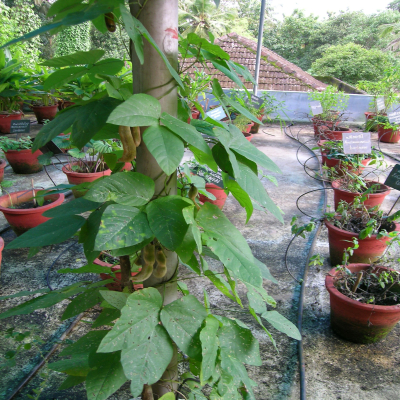Mucuna pruriens (Linn.)DC
Family : Fabaceae
Group : Aphrodisiac/spermatogenesis
Parts Used : Root , Leaf , Seed
Vernacular Names :-
| English | : | Cowhage |
| Malayalam | : | Naikurana |
| Hindi | : | Gonca |
| Sanskrit | : | Atmagupta |
| Assamese | : | Kavacha, Kuhili, Kanchkun |
| Bengali | : | Akolshi, Kaincho |
| Gujarathi | : | Kanche, Kanchan, Kavatch |
| Kannada | : | Nasuganni, Nayisonanguvalli |
| Tamil | : | Punaikkali |
| Telungu | : | Piliadugu kaila, Dulugondi |
Distribution and habitat: All over India up to 1000 m in Himalaya and in Andaman and Nicobar Island, Kerala- Kasargod, Cannanore, Wynad, Calicut, Malappuram, Trichur, Idukki, Kottayam and Pathanamthitta districts
Botany: An annual, half woody, twining herb with long cylindrical branches.
- Leaves: Alternate, pinnately 3-foliate, leaflets broadly ovate, elliptic or rhomboid-ovate, unequal at the base.
- Flowers: Large and dark purple and are borne in racemes.
- Fruit: curvy pods with 5-6 seeds, turgid, twined up at end, longitudinally ribbed and covered with dense pale brown, irritating scales. Seeds are ovoid, white, black or dull black with faint brown specks.
Properties: Emmenagogue, antichorein, vermifuge.
Chemical constituent: Seeds contain 3, 4- dihydroxy-phenylalanine (L-DOPA), alkaloids-Mucuadine, Mucuadinine, Mucuadininine and prurienidine along with mucunin, mucunadine, small amount of nicotine, various aminoacids, carbohydrates, acids, indole alkyl amines and serotonine.Seed oil contain stearic, palmitic, myristic, oleic, linoleic acid and sterol
Uses: Root infusion is used in cholera, constipation, nephropathy, elephantiasis, dropsy, neuropathy, consumption, ulcer, helminthiasis, fever and delirium. Decoction of root- diuretic and cleanser of the kidneys and also as an ointment for elephantiasis (W. Indies) Leaves - ulcer, inflammation, helminthiasis, cephalagia and general debility. Seeds- Gonorrhoea, consumption, sterility, general debility. Vinous infusion of pod- dropsy
Formulations: Musalipaka, Somaraji taila, Manmatha rasa, Vanari gutika, Shatavaryadi churna
Agro technology:
Soil and climate: This crop can be grown on a wide range of soils but it does well on sandy to clayey loam, provided drainage is adequate. The best season for planting is July-August.
Propagation: By seeds
Manures and Fertilizers: The crop should be supplied with 100 Kg N, 80 kg P and 40 kg K/ha. Phosphorus is applied as a basal dose along with FYM. The crop needs about 4-6 irrigations from November to December at intervals of 20-25 days. The crop can be protected from these insects and disease by two sprays of quinalphos at 2 ml along with mancozeb at 1.5g/ l at 30 days of growth and another 90 days of growth.
Irrigation: The crop can be grown both under rainfed and irrigated conditions. The rainfed crop is sown in June with the onset of monsoon. As an irrigated crop, it can be grown throughout the year. The seeds germinate in about 7-10 days after sowing.
Harvest: Best time for harvesting the crop is January- February. Hence, the dry pods are harvested 3 to 4 times in the season. Then the seeds are separated from the husk by winnowing.

